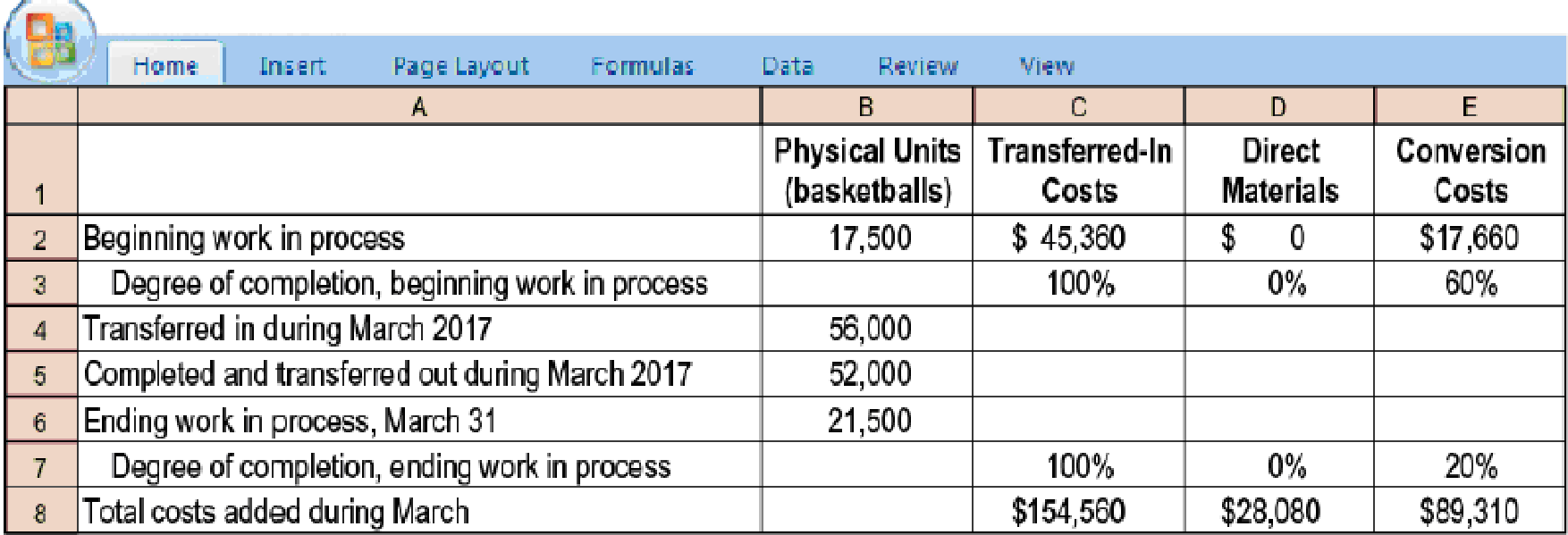
Concept explainers
Transferred-in costs, FIFO method. Refer to the information in Problem 17-43. Suppose that Spelling Sports uses the FIFO method instead of the weighted-average method. Assume that all other information, including the cost of beginning WIP, is unchanged.
- 1. Using the FIFO process-costing method, complete Problem 17-43.
Required
- 2. If you did Problem 17-43, explain any difference between the cost of work completed and transferred out and the cost of ending work in process in the stitching department under the weighted-average method and the FIFO method.
17-43 Transferred-in costs, weighted-average method. Spelling Sports, which produces basketballs, has two departments: cutting and stitching. Each department has one direct-cost category (direct materials) and one indirect-cost category (conversion costs). This problem focuses on the stitching department.
Basketballs that have undergone the cutting process are immediately transferred to the stitching department. Direct material is added when the stitching process is 70% complete. Conversion costs are added evenly during stitching operations. When those operations are done, the basketballs are immediately transferred to Finished Goods.
Spelling Sports uses the weighted-average method of

- 1. Summarize total stitching department costs for March 2017, and assign these costs to units completed (and transferred out) and to units in ending work in process.
Required
- 2. Prepare
journal entries for March transfers from the cutting department to the stitching department and from the stitching department to Finished Goods.
Trending nowThis is a popular solution!

Chapter 17 Solutions
HORNGRENS COST ACCOUNTING W/ACCESS
- Ginx Enterprises had $250,000 in sales on account last year. The beginning accounts receivable balance was $15,000, and the ending accounts receivable balance was $22,000. The company's average collection period (age of receivables) was closest to: (a) 19.54 days. (b) 36.68 days. (c) 27.02 days. (d) 52.45 days. Need answerarrow_forwardHelparrow_forwardnonearrow_forward
- Principles of Accounting Volume 2AccountingISBN:9781947172609Author:OpenStaxPublisher:OpenStax College
 Managerial AccountingAccountingISBN:9781337912020Author:Carl Warren, Ph.d. Cma William B. TaylerPublisher:South-Western College Pub
Managerial AccountingAccountingISBN:9781337912020Author:Carl Warren, Ph.d. Cma William B. TaylerPublisher:South-Western College Pub Principles of Cost AccountingAccountingISBN:9781305087408Author:Edward J. Vanderbeck, Maria R. MitchellPublisher:Cengage Learning
Principles of Cost AccountingAccountingISBN:9781305087408Author:Edward J. Vanderbeck, Maria R. MitchellPublisher:Cengage Learning


